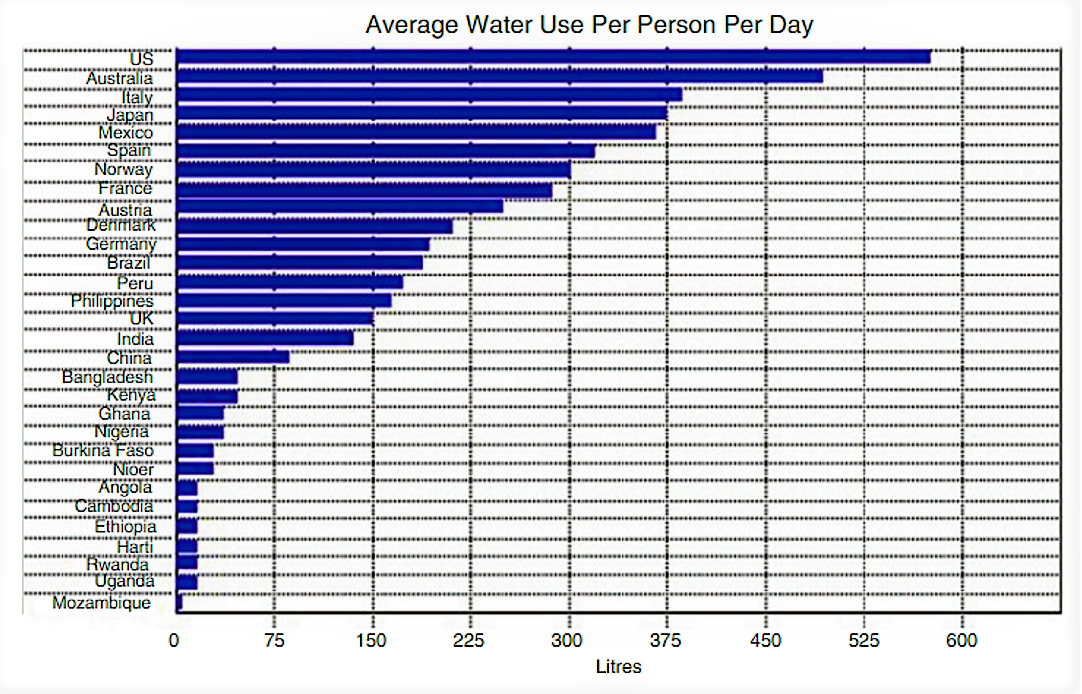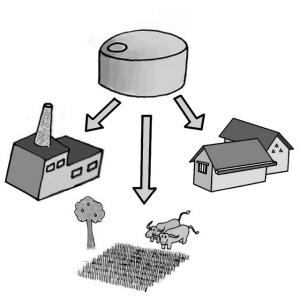Water of a desired quality is often scarce, and has to be allocated to different uses such as human consumption, sanitation, the production of food, industry, transport, energy, etc. Allocation has to be done in a manner that achieves economic efficiency, social equity and environmental sustainability. Water allocation therefore makes trade-offs between the priorities of stakeholders, profitability and economic returns, reliability of water supply, equity, and sustenance of ecosystems. Even though water for sanitation is universally classified as a basic need, it is often forgotten in water allocation plans. Therefore it is important that sanitation planners also participate in allocation planning.
Because there is often not enough water of a desired quality to satisfy all the demands for its different uses, decisions have to be made on how it will be shared between the users and uses that demand it. This is the practice of water allocation. It is a key universal function of water management whose objective is to maximise the societal benefits derived from water. The societal benefits can be classified as economic, social and environmental, each with a corresponding principle - efficiency, equity and suitability respectively (DINAR et al. 1997). Economic efficiency is concerned with the wealth that can be generated from a river basin’s water resources. It requires that in deciding where to allocate a unit of water, the sector generating the highest returns will be prioritised. Social equity means that everyone has fair opportunities to access water resources. It also means that water for drinking and sanitation needs should be made available for everyone including the poor who cannot pay for it. The sustainability principle gives recognition to the environment as a user of water, with direct and indirect benefits for human beings and the ecological system.
One of the fundamentals of water allocation is that any form of abstraction, transfer, storage or other influences on natural stream has effects on the entire downstream river system (CAP-NET 2008). The water authority must carry out a system analysis (see also material flow analysis) to understand the entire river basin including the associated groundwater and how it affects the livelihoods and economic activities in the basin and vice versa. It is important to allocate water based on its availability and the demands inferred from the ongoing and planned socio-economic developments (such as population growth, and increases in households with improved sanitation). Water allocation projections provide an important planning tool for adapting to changes in the availability of water. An assessment of environmental water requirements is required so as to reserve a minimum flow to sustain ecosystem services (including water purification, and the actual continued flow of clean water).
For an allocation system to work, all water users (or at least the major users) should be identified, and registered along with their agreed share of water allocated for abstraction or storage (and the conditions that come with the allocation). This is the establishment of a permitting system for the purposes of implementing and monitoring the allocation system. The following are the characteristics associated with an effective permitting system (UNITED NATIONS 2000):
- It is time bound with legal certainty (see also policies and legal framework).
- Extreme conditions are described (such as droughts) where special rules apply.
- Fees are defined for different uses and volume categories.
- For each permit, the volume of abstraction, the abstraction rate and times, the point (geographical) of abstraction and source and the water use should be known.
Multi criteria are used to decide on allocation. The criteria make trade-offs based on the following issues: prioritisation by stakeholders; profitability and economic returns; reliability of supply; equity; sustenance of ecosystems. To assist water managers in this process, some decision support tools have been developed that generate possible outcomes of different water availability and allocation scenarios. The scenarios can then be ranked by basin stakeholders as an input to the decisions by the water authority.
Subscribe here to the new Sanitation and Water Entrepreneurship Pact (SWEP) newsletter. SWEP is a network of organizations joining hands to help entrepreneurs design and develop lasting water and sanitation businesses.
The world over, water resources policy gives priority to the water supply and sanitation over other water use sectors, but in reality the allocation does not always fulfil this promise (BUTTERWORTH & SOUSSAN 2001). Water allocation plans should take into account the needs or plans for sanitation. Because allocation systems consider the intended use of water, the benefits of improved sanitation to the river basin (though for example reduced bacterial contamination of water) provide incentives for water authorities to give more water to this sector. This water is likely to be taken from agriculture and industry through demand management induced by appropriate tariffs (see also water pricing: fixed charge, increasing block tariffs and volumetric charge). For water allocation to be more effective in improving sanitation, it is important to demonstrate to water managers, the economic and ecological benefits of allocating more water to sanitation. On the other hand, planning for sanitation is more realistic when it is based on the water allocated. This may influence technology choice, towards for example water saving options or devices (see also optimisation of water use on 3 categories of Water Use section).

Allocation may be practised at different levels, with the river basin authorities being the most logical starting point for allocating raw water. Local authorities and water utilities also allocate water within their areas of jurisdiction. There are many cases where user based allocation is practised. This is typically at small scale, in rural areas where local communities or irrigators make high investments in the water supply infrastructure (and its operation and maintenance) and have a good cooperation. In such cases, allocation decisions are usually limited to devising a system of delivering or abstracting a fair share of water for household or irrigation water use. Legal authority is essential before an authority can allocate water. For user based allocation the authority maybe based on traditional rules and governance systems. Where there is no perception of scarcity, allocation is not likely to be enforceable. Allocation is also not possible when there is no knowledge of the system and the water users and uses within a hydrologic unit.
Water Supply and Sanitation and Integrated Water Resources Management: why seek better integration?
This document has its focus on the importance of the link between water supply, sanitation and Integrated Water Resources Management.
BUTTERWORTH, J. SOUSSAN, J. (2001): Water Supply and Sanitation and Integrated Water Resources Management: why seek better integration?. Andhra Pradesh: Water, Households and Rural Livelihoods Project URL [Visita: 10.04.2019]Training Manual on Integrated Water Resources Management for River Basin organisations
This training manual focuses of specific water resources management functions carried out by River Basin Organisations. There is a specific module on water allocation with PowerPoint a presentation.
CAP-NET (2008): Training Manual on Integrated Water Resources Management for River Basin organisations. Pretoria: Cap-Net URL [Visita: 10.04.2019]Water allocation mechanisms - principles and examples
This document is good to get an overview about water allocation mechanisms. It is a practical help because it includes some examples.
DINAR, A. ROSEGRANT, M. W. MEINZEN-DICK, R. (1997): Water allocation mechanisms - principles and examples. Washington, D.C.: World Bank and International Food Policy Research Institute URL [Visita: 10.10.2010]Principles and Practices of Water Allocation among Water-Use Sectors
Water rights and water allocation issues and challenges for Asia
With a focus on Asia, the report aims to increase clarity on the concepts and terminology surrounding water rights and water allocation. It makes use of findings from the cross-country comparisons in Asian countries.
BIRD, J. LINCKLAEN ARRIENS, W. CUSTODIO, D. von (2009): Water rights and water allocation issues and challenges for Asia. Manila, The Philippines, Asian Development Bank URL [Visita: 22.04.2012]Water Supply and Sanitation and Integrated Water Resources Management: why seek better integration?
This document has its focus on the importance of the link between water supply, sanitation and Integrated Water Resources Management.
BUTTERWORTH, J. SOUSSAN, J. (2001): Water Supply and Sanitation and Integrated Water Resources Management: why seek better integration?. Andhra Pradesh: Water, Households and Rural Livelihoods Project URL [Visita: 10.04.2019]Water allocation mechanisms - principles and examples
This document is good to get an overview about water allocation mechanisms. It is a practical help because it includes some examples.
DINAR, A. ROSEGRANT, M. W. MEINZEN-DICK, R. (1997): Water allocation mechanisms - principles and examples. Washington, D.C.: World Bank and International Food Policy Research Institute URL [Visita: 10.10.2010]Urban Water and Sanitation Services: An IWRM Approach
This technical paper gives guidance on how the IWRM approach can offer urban management tools which are automatically compatible with efficiency, equity and environmental sustainability for urban sanitation services.
REES, J. (2006): Urban Water and Sanitation Services: An IWRM Approach. Sweden: Global Water Partnership URL [Visita: 15.10.2010]Assessing Direct Economic Effects of Reallocating Irrigation Water to Alternative Uses
Irrigation water reallocations are playing an increasingly important role both in developed and developing countries. With growing urban and environmental water demands, rising cost for the development of new water supplies, and irrigated agriculture usually including the least economically valuable use of water, transfers of irrigation water to alternative uses are increasing. However, such reallocations are often controversial, and it is often questioned whether the benefits resulting from these transactions are large enough to outweigh the associated costs. The study, which is based on Economic and Sector Work (ESW) in the Water Anchor, reviews the experience with irrigation water transfers, including the involvement of the World Bank.
THE WORLD BANK (2011): Assessing Direct Economic Effects of Reallocating Irrigation Water to Alternative Uses. Concepts and an Application. URL [Visita: 17.10.2011]Green Growth and Water Allocation
This publication is part of a wider series of publications based on several international meetings held in the Netherlands addressing key water issues and challenges. This series reflects the rich expertise of participants from various geographical and disciplinary backgrounds on water allocation, green growth, water resources management and international water law. It also contains a number of case studies related to these topics.
PRIMOT, S. ; VALK, M.R. van der ; KEENAN, P. (2013): Green Growth and Water Allocation. (= Papers Presented at a Workshop in Wageningen, the Netherlands, 22-23 November 2012 ). Amsterdam: The Netherlands National Committee IHP-HWRP and The Netherlands National Commission for the United Nations Educational, Scientific and Cultural Organization (UNESCO) URL [Visita: 09.09.2013]Training Manual on Integrated Water Resources Management for River Basin organisations
This training manual focuses of specific water resources management functions carried out by River Basin Organisations. There is a specific module on water allocation with PowerPoint a presentation.
CAP-NET (2008): Training Manual on Integrated Water Resources Management for River Basin organisations. Pretoria: Cap-Net URL [Visita: 10.04.2019]Allocating National Resources in the Water and Sanitation Sector
This briefing note summarises the importance of good sector resource allocation and sets out some mechanisms for achieving this in theory and in practice. It has useful examples for allocating water to sanitation.
FISHER, J. (2005): Allocating National Resources in the Water and Sanitation Sector. (= Well Briefing Note 11 ). Leicestershire: Loughborough University URL [Visita: 10.04.2019]AQUASTAT - FAO's Information System on Water and Agriculture
The AQUASTAT online database is a collection of information and analyses on water resources, water uses, and agricultural water management with an emphasis on countries in Africa, Asia, Latin America and the Caribbean.
Water, Households and Rural Livelihoods Project (WHiRL)
This is a website of a project called “Water, Households and Rural Livelihoods Project (WHiRL), which promotes access of the poor to sustainable water supplies for domestic and productive uses in areas of water scarcity. Many of the case studies are from India and South Africa
Water resources management and allocation
A web page with research papers looking at water resource management and allocation in the context of growing competition for and conflict over water.



